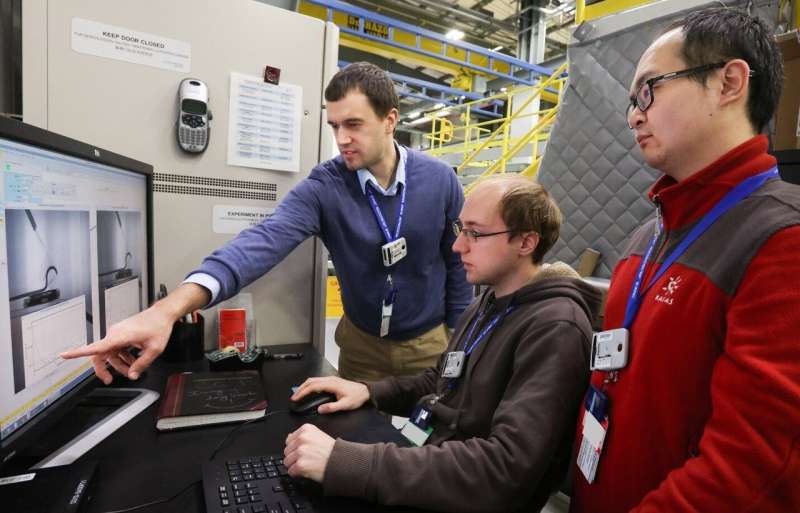Through thick and thin: Neutrons track lithium ions in battery electrodes

Lithium-ion batteries are expected to have a global market value of $47 billion by 2023. They are used in numerous applications, because they offer relatively high energy density (storage capacity), high operating voltage, long shelf life and little "memory effect"—a reduction in a rechargeable battery's maximum capacity due to incomplete discharges in previous uses. However, factors such as safety, charge-discharge cycling and operating life expectancy continue to limit the effectiveness of lithium-ion batteries in heavy-duty applications, such as for powering electric vehicles.
Researchers from the University of Virginia School of Engineering are employing neutron-imaging techniques at Oak Ridge National Laboratory to probe lithium-ion batteries and obtain insights into the electrochemical characteristics of the batteries' materials and structures. Their research, published in the Journal of Power Sources, focused on tracking the lithiation and delithiation—or charge and discharge—processes in lithium-ion battery electrodes using thin and thick sintered samples of two electroactive materials, lithium titanate and lithium cobalt oxide.
Understanding how the lithium moves in battery electrodes is important in designing batteries that can charge and discharge at faster rates. In some batteries this is the slowest process, which means that improving the lithium movement through the electrodes could result in batteries that can be recharged much quicker.
"When electrodes are relatively thick, transport of lithium ions through the porous material and separator architecture can limit charge and discharge rates," said Gary Koenig, an associate professor of chemical engineering at UVA Engineering. "To develop methods of improving lithium ion transport through an electrode's porous void regions filled with electrolyte, we need to first be able to track the transport and distribution of the ions within a cell during the charge and discharge processes."
According to Koenig, other techniques such as high-resolution X-ray diffraction can provide detailed structural data during electrochemical processes, but this method typically averages relatively large volumes of the material. Similarly, X-ray phase imaging can visualize salt concentrations in battery electrolytes, but the technique requires a special spectrochemical cell and can only access composition information between the electrode regions.
To obtain detailed information across a wider area, the researchers conducted their studies using neutrons at the cold neutron imaging beamline at Oak Ridge's High Flux Isotope Reactor.
"Lithium has a large absorption coefficient for neutrons, which means that neutrons passing through a material are highly sensitive to its lithium concentrations," said Ziyang Nie, lead author and graduate student in Koenig's group. "We demonstrated we could use neutron radiographs to track in situ lithiation in thin and thick metal oxide cathodes inside battery cells. Because neutrons are highly penetrating, we did not have to build custom cells for the analysis and were able to track the lithium across the entire active region containing both electrodes and electrolyte."
Comparing the lithiation process in thin and thick electrodes is essential to aid understanding of the effects of heterogeneity—local variations in mechanical, structural, transport and kinetic properties—on battery life and performance. Local heterogeneity can also result in non-uniform battery current, temperatures, state of charge and aging. Typically, as the thickness of an electrode increases, so do the detrimental effects of heterogeneity on battery performance. Yet, if thicker anodes and cathodes could be used in batteries without impacting other factors, it would help increase energy storage capacities.
For the initial experiments, the thin electrode samples had thicknesses of 0.738 mm for lithium titanate and 0.463 mm for lithium cobalt oxide, while the thick lithium titanate and lithium cobalt oxide samples were 0.886 mm and 0.640 mm, respectively.
"Our immediate goal is to develop a model to help us understand how modifying the structure of an electrode, such as changing how the material is oriented or distributed, could improve ion transport properties," Koenig said. "By imaging through each sample at different points in time, we were able to create 2-D maps of lithium distribution. In the future, we plan to rotate our samples within the neutron beam to provide 3-D information that will reveal in more detail how heterogeneity impacts ion transport."
More information: Ziyang Nie et al, Probing lithiation and delithiation of thick sintered lithium-ion battery electrodes with neutron imaging, Journal of Power Sources (2019). DOI: 10.1016/j.jpowsour.2019.02.075
Provided by University of Virginia





















